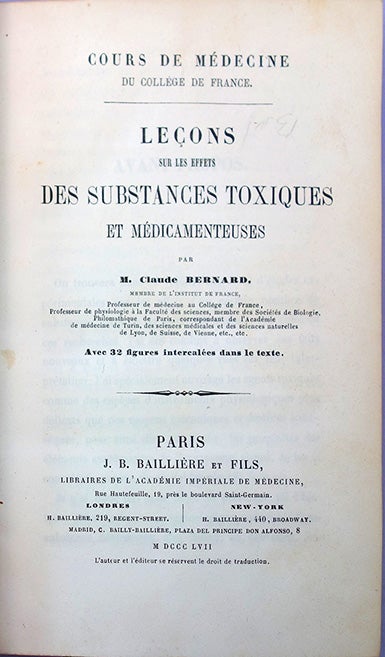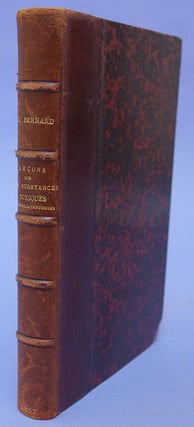Lecons sur les effets des substances toxiques et medicamenteuses.
Publisher Information: Paris: Bailliere, 1857.
Bernard, Claude (1813-78). Leçons sur les effets des substances toxiques et médicamenteuses. vii, 488pp. Text illustrations. Paris: Baillière, 1857. 214 x 136 mm. 19th century quarter morocco, marbled boards, spine a bit faded and worn, one corner bumped. Light toning but very good. Bookplate of French chemist and pharmacologist Emile Bourquelot (1851-1921). From the library of American cardiologist Myron Prinzmetal (1980-87), with his bookplate; Prinzmetal’s gift inscription to pharmacologist and medical historian Chauncey D. Leake (1896-1978) on the half-title: “To my dear & wonderful teacher & friend C. L. from M. P. 2-20-62”; Leake’s note on the rear endpaper: “The best copy of this classic I ever saw.” Laid in is a slip of paper with Prinzmetal’s pencil note: “C. L. / F[. . .] & Walter loved this. / M. P.”; also a photograph of a bronze statue of Bernard annotated by Leake on the verso.
First Edition. The great French physiologist Claude Bernard made significant contributions to anesthesia, developing a theory of general anesthesia based on experimental evidence and introducing new anesthetic techniques. His Leçons sur les effets des substances toxiques summarizes Bernard’s researches on anesthetics and related substances up to the time of writing: “The 1857 lectures on toxic substances contained descriptions of the analyzed gaseous content of blood and a full account of the mechanism of toxicity of carbon monoxide. He demonstrated that the lethal effects of carbon monoxide were due to irreversible combination with hemoglobin, thus preventing transport of oxygen to tissues. The lectures included discussions on asphyxia and artificial respiration. In a clear account of curare’s effects, he demonstrated that the drug causes paralysis by blocking the transmission of nerve impulses to muscles. After consideration of the poisonous actions of strychnine, venoms and nicotine, Bernard discussed the toxicity of alcohol, ether and chloroform, noting their interference with pancreatic and intestinal secretions, and with liver functions. Ether, he suggested, rendered an animal diabetic, probably by disturbing the glycogenic function of the liver. This was one of his great discoveries” (Leake, p. 112).
This copy has an excellent provenance, having belonged to Emile Bourquelot, who pioneered in the study of plant glycosides; Myron Prinzmetal, who made numerous important contributions to cardiology (see Garrison-Morton.com 2881) and was one of the first to explore the link between diet and heart disease; and Chauncey D. Leake, discoverer of the anesthetic properties of divinyl ether (see Garrison-Morton.com 5713), who had been Prinzmetal’s teacher. Leake, “Historical note: Claude Bernard and anesthesia,” Anesthesiology 8 (1971): 112-113.
Book Id: 43590Price: $950.00



